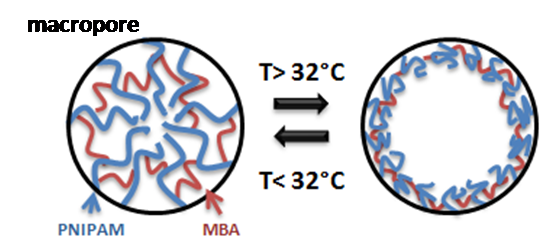Nina Sarvašová, Viola Tokárová, Jitka Čejková, Aleš Zadražil, František Štěpánek
Smart polymers can be defined as macromolecules that undergo fast and reversible changes from hydrophilic to hydrophobic microstructure. These molecular-level changes, which are triggered by changes in the microenvironment (such as variations in temperature, pH, ionic strength, light, or the concentration of specific substances such as sugars or proteins) are apparent at the macroscopic level as precipitate formation in solutions of smart polymers, as changes in wettability of the surface to which a smart polymer is grafted, or as a significant shrinking/swelling of a hydrogel. The changes are fast and reversible, i.e., the system returns to its initial state when the trigger is removed.
One of the most frequently used smart polymers used in our laboratory is a thermo-sensitive polymer, poly-N-isopropylacrylamide (PNIPAM). Chains of PNIPAM contain both hydrophilic amide groups and hydrophobic isopropyl groups (see Figure). When PNIPAM is dispersed in water at low temperatures (below the so-called lower critical solution temperature (LCST) ~32 °C), the amide groups interact strongly with water molecules through hydrogen bonding and the polymer swells. At higher temperatures (above LCST), the hydrogen bonds between water and the amide groups are disrupted, water acts as a poor solvent and is expelled from PNIPAM. As a result the polymer network collapses and the particles shrink dramatically. The temperature change causes not only a volume response but affects also the diffusion rate of both small and large molecules through PNIPAM and its adhesion characteristics (from hydrophilic to hydrophobic surface character).
Shrinking/swelling behaviour of composite PNIPAM/SiO2 microcapsules (temperature changes 20 – 45 – 20 °C)
(Čejková, J., Hanuš, J. & Štěpánek, F. Investigation of internal microstructure and thermo-responsive properties of composite PNIPAM/silica microcapsules. Journal of Colloid and Interface Science 346, 352-360 (2010))
Publications
- Sarvašová N., Ulbrich P., Tokárová V., Zadražil A., Štěpánek F., “Artificial swarming: towards radiofrequency control of reversible micro-particle aggregation and deposition”, Powder Technol. 278, 17-25 (2015)
- Zadražil A., Tokárová V., Štěpánek F., “Remotely triggered release from composite hydrogel sponges”, Soft Matter 8, 1811-1816 (2012)
- Tokárová V., Pittermannová A., Čech J., Ulbrich P., Štěpánek F., “Thermo-responsive adhesion properties of composite hydrogel microcapsules”, Soft Matter 8, 1087-1095 (2012)
- Zadražil A., Štěpánek F., “Investigation of thermo-responsive optical properties of a composite hydrogel”, Coll. Surf. A: Physicochem. Eng. Aspects 372, 115-119 (2010)
- Čejková J., Hanuš J., Štěpánek F., “Investigation of internal microstructure and thermo-responsive properties of composite PNIPAM/silica microcapsules”, J. Coll. Interf. Sci. 346, 352-360 (2010)


